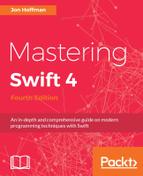Closures are self-contained blocks of code that can be passed around and used throughout our application. We can think of the Int type as a type that stores an integer and a String type as a type that stores a string. In this context, a closure can be thought of as a type that contains a block of code. What this means is that we can assign closures to a variable, pass them as arguments to functions, and return them from a function.
Closures have the ability to capture and store references to any variable or constant from the context in which they were defined. This is known as closing over the variables or constants and, for the most part, Swift will handle the memory management for us. The only exception is in creating a strong reference cycle, and we will look at how to resolve this in the Creating strong reference cycles with closures section of this chapter.
Closures in Swift are similar to blocks in Objective-C; however, closures in Swift are a lot easier to use and understand. Let's look at the syntax used to define a closure in Swift:
{
(parameters) -> return-type in
statements
}
The syntax used to create a closure looks very similar to the syntax we use to create functions and, in Swift, global and nested functions are closures. The biggest difference in the format between closures and functions is the in keyword. The in keyword is used in place of curly brackets to separate the definition of the closure's parameter and return types from the body of the closure.
There are many uses for closures, and we will go over a number of them later in this chapter, but first we need to understand the basics of closures. Let's start by looking at some very basic closures so that we can get a better understanding of what they are, how to define them, and how to use them.
